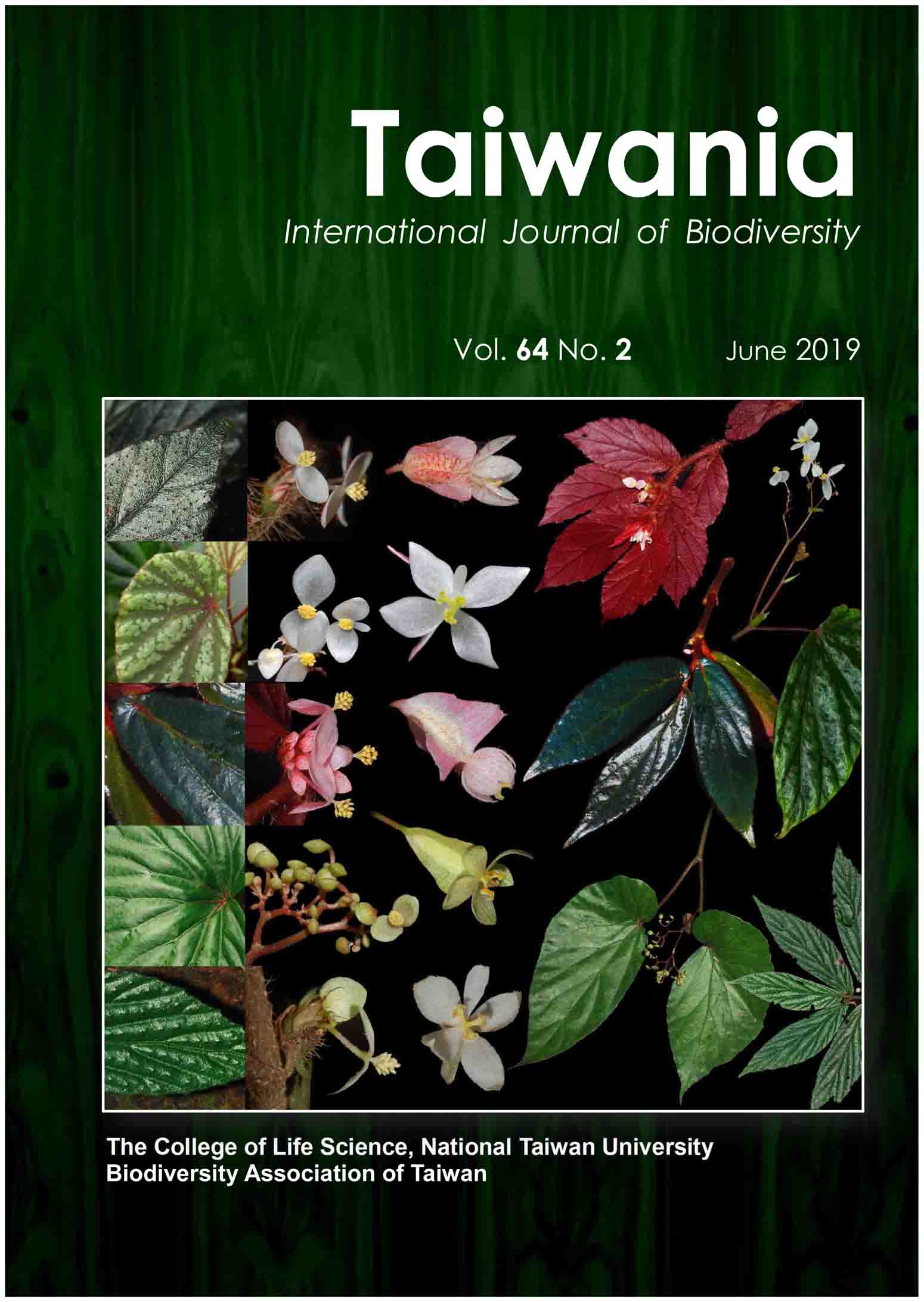Research Paper
The pathogenicity of basidiospores of Phellinus noxius which causes brown root rot disease in Taiwan
Wen-Wei Hsiao, Ting- Hsuan Hung, En-Jang Sun
Published on: 13 May 2019
Page: 189 - 194
DOI: 10.6165/tai.2019.64.189
Abstract
The role of basidiospores of Phellinus noxius in nature has not been clearly elucidated since brown root rot disease was discovered. Previously, it was reported that P. noxius rarely produces basidiocarps in nature, while a total of 33 new tree host species bearing basidiocarps were recently found in Taiwan. The more-abundant basidiospores were collected for germination and infection studies in this paper. Fresh basidiospores were collected from live basidiocarps growing on a small-leafed banyan (Ficus microcarpa), and the basidiospores were rinsed out. The germination experiment revealed that they could germinate in all kinds of liquids including rainwater, with germination rates usually exceeding 50%. The direct inoculation of basidiospore suspensions at concentration of 105~106 spores/mL on four tree species was consistently unsuccessful. The same spore suspension was used to inoculate wood chips from Taiwan zelkova (Zelkova serrata) sapwood. After 2 months, some of the wood chips had been colonized by basidiospores, showing dark-brown line or network symptoms. Using these colonized wood chips, we successfully inoculated wounded roots of Taiwan zelkova seedlings within 3 months, proving the virulence and role of basidiospores in nature. Since 2007, 13 cases of twig or stem infection by P. noxius were found in the field, confirming transmission by basidiospores. In Taiwan, due to the high frequency of typhoon damage to trees, abundant stem wounds should act as important sites for basidiospore deposition and infection. This could facilitate the long-distance dispersal of this disease in nature.
Keyword: Basidiospore, Brown root rot, Long-distance dispersal, Pathogenicity test, Phellinus noxius, Taiwan
Literature Cited
Akiba, M., Y. Ota, I.J. Tsai, T. Hattori, N. Sahashi and T. Kikuchi. 2015. Genetic differentiation and spatial structure of Phellinus noxius, the causal agent of brown root rot of woody plants in Japan. PLoS One. 10(10):e0141792.
DOI: 10.1371/journal.pone.0141792View Article
Google Scholar
Ann, P. J., T.T. Chang and W.H. Ko. 2002. Phellinus noxius brown root rot of fruit and ornamental trees in Taiwan. Plant Dis. 86(8):820-826.
DOI: 10.1094/PDIS.2002.86.8.820View Article
Google Scholar
Ann, P.J. and W.H. Ko. 1992. Decline of longan: association with brown root rot caused by Phellinus noxius. Plant Pathol. Bull. 1:19-25.
Ann, P.J., H.L. Lee and T.C. Huang. 1999a. Brown root rot of 10 species of fruit trees caused by Phellinus noxius in Taiwan. Plant Dis. 83(8):746-750.
DOI: 10.1094/PDIS.1999.83.8.746View Article
Google Scholar
Ann, P.J., H.L. Lee and J.N. Tsai. 1999b. Survey of brown root rot disease of fruit and ornamental trees caused by Phellinus noxius in Taiwan. Plant Pathol. Bull. 8:51-60.
Bolland, L. 1984. Phellinus noxius: cause of a significant root-rot in Queensland hoop pine plantations. Aust. For. 47(1):2-10.
DOI: 10.1080/00049158.1984.10675972View Article
Google Scholar
Chang, T.T. 1992. Decline of some forest trees associated with brown root rot caused by Phellinus noxius. Plant Pathol. Bull. 1:90-95.
Chang, T. T. 1995a. Decline of nine tree species associated with brown root rot caused by Phellinus noxius in Taiwan. Plant Dis. 79(9):962-965.
DOI: 10.1094/PD-79-0962View Article
Google Scholar
Chang, T. T. 1995b. A selective medium for Phellinus noxius. Eur. J. For. Path. 25(4):185-190.
DOI: 10.1111/j.1439-0329.1995.tb01002.xView Article
Google Scholar
Chang, T. T. and W. W. Yang. 1998. Phellinus noxius in Taiwan: distribution, host plants and the pH and texture of the rhizosphere soils of infected host. Mycol. Res. 102(9):1085-1088.
DOI: 10.1017/S0953756297005571View Article
Google Scholar
Chung, C.-L., S.-Y. Huang, Y.-C. Huang, S.-S. Tzean, P.-J. Ann, J.-N. Tsai, C.-C. Yang, H.-H. Lee, T.-W. Huang, H.-Y. Huang, T.-T. Chang, H.-L. Lee and R.-F. Liou. 2015. The genetic structure of Phellinus noxius and dissemination pattern of brown root rot disease in Taiwan. PLoS One. 10(10): e0139445.
DOI: 10.1371/journal.pone.0139445View Article
Google Scholar
Chung, C.L., T.J. Lee, M. Akiba, H.H. Lee, T.H. Kuo, D. Liu, H.M. Ke, T. Yokoi, M.B. Roa, M.J. Lu, Y.Y. Chang, P.J. Ann, J.N. Tsai, C.Y. Chen, S.S. Tzean, Y. Ota, T. Hattori, N. Sahashi, R. F. Liou, T. Kikuchi and I.J. Tsai. 2017. Comparative and population genomic landscape of Phellinus noxius: A hypervariable fungus causing root rot in trees. Mol. Ecol. 26(22):6301-6316.
DOI: 10.1111/mec.14359View Article
Google Scholar
Corner, E.J.H. 1932. The identification of the brown root rot fungus. Gard. Bull. Straits Settl. 5:317-350.
Cunningham, G.H. 1965. Polyporaceae of New Zealand. N.Z. Dep. Sci. Indust. Res. Bull. 164:221-222.
Fu, C.H. 2005. Study on the Tree Brown Root Rot Disease. Ph. D. Dissertation, National Taiwan University. Taipei, Taiwan. 163 p.
Ko, W.H., J. Tomita and R.L. Short. 1986. Two natural hosts of Kretzschmaria clavus in Hawaiian forests. Plant Pathol. 35(2):254-255.
DOI: 10.1111/j.1365-3059.1986.tb02011.xView Article
Google Scholar
Pegler, D.N. and J.M. Waterson. 1968. Phellinus noxius. No. 195 in Descriptions of Pathogenic Fungi and Bacteria. Commonw. Mycol. Inst., Kew, England.
Sahashi, N., M. Akiba, M. Ishihara, K. Miyazaki and N. Kanzaki. 2010. Cross inoculation tests with Phellinus noxius isolates from nine different host plants in the Ryukyu islands, southwestern Japan. Plant Dis. 2010 Mar; 94(3):358-360.
DOI: 10.1094/PDIS-94-3-0358View Article
Google Scholar
Sawada, K. 1928. Camphor tree decline. Descriptive Catalogue of Formosan Fungi 4:86-91. (in Japanese)
Sawada, K. 1942. Bauhinia decline. Descriptive Catalogue of Formosan Fungi 7:97-98. (in Japanese)
Taiwan Environmental Protection Administration. 2018. Acid rain in Taiwan. https://acidrain.epa.gov.tw/now/04.htm.


